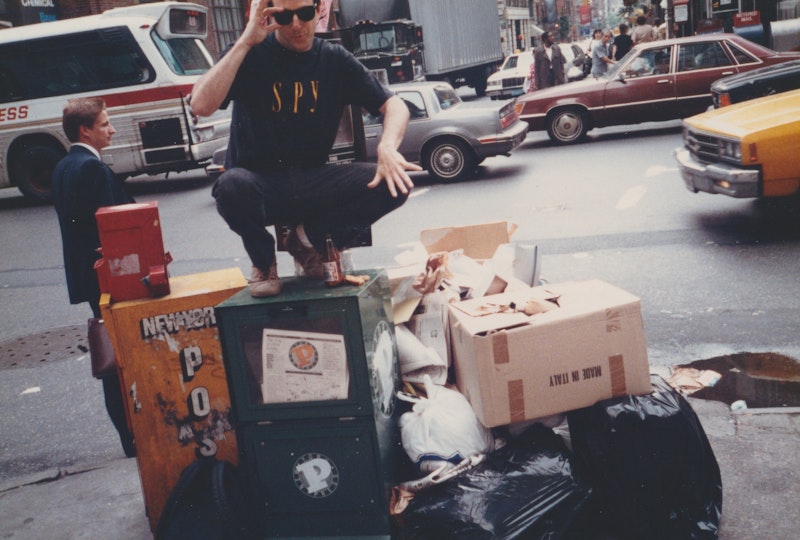In the past 15 years, on rare occasions, I’ve received a call or email from an old acquaintance or stranger asking if I’d be interested in participating with a book or documentary about New York Press and the weekly’s immersion in the “good old days” of the 1990s. (Apparently, there’s current nostalgia for that decade—which did rock—although that escapes me, just as I never got sucked into the 1950s nostalgia when I was a teenager in the early-1970s. Back then, at least, nostalgia was successfully marketed—Sha Na Na—but I’m not convinced there’s the apparatus today to take advantage of those gauzy memories.)
Last week I joined longtime friends Michael Yockel and Jennifer Bishop—absent from our usual quartet was frequent-flier Alan Hirsch, out in Los Angeles to visit his daughter’s family—for a three-hour coffee gab, an appointment we make every 10 weeks or so. It’s a lot of fun—no phones, the implicit rule of no politics—and, owning up to a contradiction from the last paragraph, there is a wave of nostalgia about the days long ago when gatherings of friends was a daily occurrence, we worked together, and not a rendezvous planned two months in advance.
About two hours into the banter, I mentioned to the Yoke and Jennifer that in the past month two former NYPress contributors emailed and outlined a prospective documentary about the paper, commandeered by a man they both like and respect. It’s flattering to be considered for such a venture, but I told the fellows that although I’d be glad to reminisce about that era, my suspicion was that the completed film might reach an audience of 200. One, documentaries are produced today like bushels of Long Island corn in August; they come and go and that’s that. Two, I’m not sure why anyone—aside from those with intimate knowledge of the paper, or fans—would watch close-ups of now-older men digging through the past. Michael, at 70, is a good-looking guy (always was), but I’ve lost any visual appeal that I might’ve once had, and suspect that’s the same for other prospective participants.
The main problem is there’s no video clips from that period that might, in fact, make for a modicum of visual attraction. Aside from assembling a weekly paper, and competing with the Village Voice—sometimes friendly, sometimes very, very nasty—we pulled a bunch of pranks. Across the street from NYP’s first office at Spring St. and Broadway was the headquarters of Paper, run by David Hershkovitz and Kim Hastreiter, a monthly that colleagues Michael Gentile, Don Gilbert, Michael Cohen and I found hilariously silly, catering to (and shamelessly puffing up celebrities) the local art scene. For a month, Don hung a Jolly Roger skull ‘n’ bones flag on one of our windows, pointed right at Paper. On occasion, there was some waving between the people in the two offices, and we cracked up later while drinking pints at Milano’s on Houston St. It was harmless, a time-killer and of a piece with the paper’s eclectic, hit-or-miss content.
We had enormous respect for Spy, the monthly magazine that was founded in 1986 by Kurt Andersen, Graydon Carter and Tom Phillips, Jr. By chance, I bought the first issue in October of ’86 at a newsstand in Penn Station on a Sunday morning. Three of my brothers and I attended a Mets-Astros playoff game at Shea Stadium, and then continued to behave badly—booze-wise—and on the Amtrak back to Baltimore, though I was practically seeing double, I was blown away by this new magazine, easily the smartest media entry of that decade, with meticulous, clever and biting stories and shorts, equaled by the most innovative design—which was widely imitated by other magazines once their art directors got around to noticing it. Spy was a brilliant comet; in one of my first MUGGER columns for NYP, I suggested the founders sell it and reap the enormous premium it’d fetch in a market when media traded hands monthly. They did do that in 1991, but after the men who squeezed the juice moved on to other pursuits, the luster was gone.
I don’t recall the precise who-what-when-where-why of Gentile and I trailing a Spy employee around the neighborhood (picture above)—Hank was a very good sport—for a story of ours, but again the two of us laughed so mightily I had to remove my glasses to wipe away the tears. If Andersen or Carter even noticed our short bit, they didn’t let on. As it happened, when Spy left the Puck Building for grander Union Square quarters, NYPress took over their ninth floor offices, and when we moved in, Carter left me a bottle of wine along with a gracious note (he was appreciative of a ringing endorsement in the City Paper column “RUMP”—a precursor to “MUGGER”—and invited me to lunch just before I sold CP, and gave advice about the new, yet unnamed paper I planned to start in Manhattan). A documentary about Spy and what it spawned would capture my attention.
Clues for the year: Oliver North and John Poindexter are indicted; Sonic Youth’s Daydream Nation comes out; a ceasefire ends the Iran-Iraq war; U.S. embassy in Moscow is torn down; the first World AIDS day is held; Nicholas Braun is born and Hal Ashby dies; Lyndon LaRouche convicted of mail fraud; Hüsker Dü break up and The Smashing Pumpkins form; Clayton Kershaw is born and Chet Baker dies; The Last Temptation of Christ is released; and Anne Tyler’s Breathing Lessons is published, along with the film adaptation of her novel The Accidental Tourist.
—Follow Russ Smith on Twitter: @MUGGER2023

